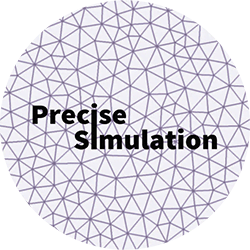
|
FEATool Multiphysics
v1.17.5
Finite Element Analysis Toolbox
|

|
FEATool Multiphysics
v1.17.5
Finite Element Analysis Toolbox
|
EX_LINEARELASTICITY2 Example for deflection of a bracket.
[ FEA, OUT ] = EX_LINEARELASTICITY2( VARARGIN ) Example to calculate displacements and stresses for a bracket with a circular hole.
Accepts the following property/value pairs.
Input Value/{Default} Description
-----------------------------------------------------------------------------------
E scalar {200e9} Modulus of elasticity
nu scalar {0.3} Poissons ratio
force scalar {1e4} Load force
l scalar {0.2} Length of bracket
t scalar {0.02} Thickness of bracket
r scalar {0.08} Radius of bracket hole
hmax scalar {0.01} Max grid cell size
sfun string {sflag2} Shape function for displacements
iplot scalar 0/{1} Plot solution (=1)
.
Output Value/(Size) Description
-----------------------------------------------------------------------------------
fea struct Problem definition struct
out struct Output struct
cOptDef = { ...
'E', 200e9;
'nu', 0.3;
'force', 1e4;
'l', 0.2;
't', 0.02;
'r', 0.08-1e-5;
'hmax', 0.01;
'sfun', 'sflag2';
'iplot', 1;
'tol', 0.05;
'fid', 1 };
[got,opt] = parseopt(cOptDef,varargin{:});
fid = opt.fid;
% Geometry definition.
fea.sdim = { 'x' 'y' 'z' }; % Coordinate names.
gobj1 = gobj_block( 0, opt.t, 0, opt.l, 0, opt.l, 'B1' );
gobj2 = gobj_block( 0, opt.l, 0, opt.l, (opt.l-opt.t)/2, (opt.l+opt.t)/2, 'B2' );
gobj3 = gobj_cylinder( [opt.l/2 opt.l/2 opt.l/2-opt.t], opt.r, 2*opt.t, 3, 'C1' );
fea.geom.objects = { gobj1 gobj2 gobj3 };
fea = geom_apply_formula( fea, 'B1+B2-C1' );
% Grid generation.
fea.grid = gridgen( fea, 'hmax', opt.hmax, 'fid', fid, 'intb', false );
% Problem definition.
fea = addphys(fea,@linearelasticity);
fea.phys.el.eqn.coef{1,end} = { opt.nu };
fea.phys.el.eqn.coef{2,end} = { opt.E };
fea.phys.el.sfun = { opt.sfun opt.sfun opt.sfun };
% Boundary conditions.
dtol = 2e-2;
fixbdr = findbdr( fea, ['x<=',num2str(dtol*1e-1)] ); % Right boundary number.
forcebdr = findbdr( fea, ['x>=',num2str(opt.l-dtol)] ); % Left boundary number.
% Fix right boundary (set zero Dirichlet BCs).
n_bdr = max(fea.grid.b(3,:)); % Number of boundaries.
bctype = num2cell( zeros(3,n_bdr) ); % First set homogenous Neumann BCs everywhere.
[bctype{:,fixbdr}] = deal( 1 ); % Set Dirchlet BCs for right boundary.
fea.phys.el.bdr.coef{1,5} = bctype;
% Apply negative z-load to left outer boundary.
bccoef = num2cell( zeros(3,n_bdr) );
bccoef{3,forcebdr} = -opt.force;
fea.phys.el.bdr.coef{1,end} = bccoef;
% Parse and solve problem.
fea = parsephys( fea );
fea = parseprob( fea );
st = warning();
warning('off')
fea.sol.u = solvestat( fea, 'fid', fid );
warning('on')
for i=1:length(st)
builtin( 'warning', st(i).state, st(i).identifier );
end
% Postprocessing.
if ( opt.iplot>0 )
DSCALE = 5000;
subplot(2,2,1)
postplot( fea, 'surfexpr', 'u' )
title( 'x-displacement' )
view([30 20])
subplot(2,2,3)
postplot( fea, 'surfexpr', 'v' )
title( 'y-displacement' )
view([30 20])
subplot(2,2,2)
postplot( fea, 'surfexpr', 'w' )
title( 'z-displacement' )
view([30 20])
subplot(2,2,4)
dp = zeros(size(fea.grid.p));
for i=1:3
dp(i,:) = DSCALE*evalexpr( fea.dvar{i}, fea.grid.p, fea );
end
fea_disp.grid = fea.grid;
fea_disp.grid.p = fea_disp.grid.p + dp;
plotgrid( fea, 'facecolor', [.95 .95 .95], 'edgecolor', [.8 .8 1], ...
'selcells', selcells(fea,['x>',num2str(1.5*opt.t)]) )
hold on
plotgrid( fea_disp )
title(['Displacement plot (at ',num2str(DSCALE),' times scale)'])
view([30 20])
end
% Error check.
xdisp = fea.sol.u(fea.eqn.dofm{1}(:));
ydisp = fea.sol.u(fea.eqn.dofm{2}(:)+fea.eqn.ndof(1));
zdisp = fea.sol.u(fea.eqn.dofm{3}(:)+sum(fea.eqn.ndof(1:2)));
xdisp = [ min(xdisp) max(xdisp) ];
ydisp = [ min(ydisp) max(ydisp) ];
zdisp = [ min(zdisp) max(zdisp) ];
xdisp_ref = [ -8.971e-7 8.971e-7 ];
ydisp_ref = [ -9.556e-8 9.605e-8 ];
zdisp_ref = [ -1.09e-5 1.065e-8 ];
svm_ref = [ 6.252756 1.779065e6 ];
out.xdisp = xdisp;
out.ydisp = ydisp;
out.zdisp = zdisp;
out.err = abs(zdisp(1) - zdisp_ref(1))/abs(zdisp_ref(1));
out.pass = out.err<opt.tol;
if ( nargout==0 )
clear fea out
end